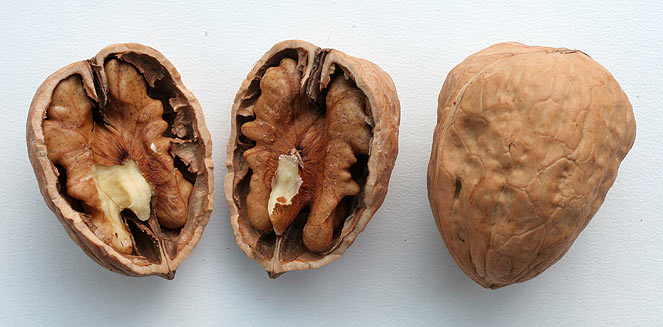|
Juglans regia (Walnut, Persian walnut, European
walnut) Life
> eukaryotes >
Archaeoplastida >
Chloroplastida
>
Charophyta > Streptophytina > Plantae (land plants)
> Tracheophyta (vascular plants) > Euphyllophyta > Lignophyta (woody plants)
> Spermatophyta (seed plants) > Angiospermae (flowering
plants) > Eudicotyledons > Core Eudicots > Rosids >
Eurosid I > Order: Fagales > Family: Juglandaceae
 |
|
Walnuts. [photo H. Robertson, Iziko
©] |
Juglans regia is native to the region in Eurasia
extending from the Near East through to the Himalayas and on to Western China.
Walnuts must have been harvested from earliest times but the earliest records of
actual growing of orchards of walnut trees go back to classical Greek and Roman
times. Besides the nuts, trees are also a source of high quality wood used for
furniture and gunstocks. Growing of walnuts in Europe began in the 1500's. They
are now grown worldwide and the largest production is from
California.
Walnuts are an excellent source of zinc, copper,
phosphorus and thiamin and a good source of iron and potassium.
There is also the Black walnut, also known as the American
walnut, Juglans nigra.
Uses
- Walnuts can be eaten raw or roasted.
- They are used as an ingredient in salads, baking and
cooking.
- Walnut wood is one of the best for making beautiful
furniture and for making gun stocks.
References
-
Anon. 2002. Encyclopedia of Foods. A Guide
to Healthy Nutrition. Academic Press, San Diego, California.
-
Sauer, J.D. 1993. Historical geography of
crop plants - a select roster. CRC Press, Boca Raton, Florida.
Text by Hamish G. Robertson
|
